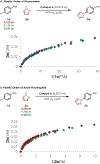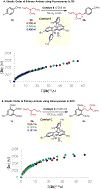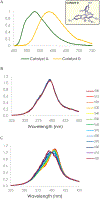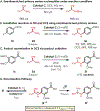Mechanistic Investigations into Amination of Unactivated Arenes via Cation Radical Accelerated Nucleophilic Aromatic Substitution
- PMID: 35944280
- PMCID: PMC10037305
- DOI: 10.1021/jacs.2c04577
Mechanistic Investigations into Amination of Unactivated Arenes via Cation Radical Accelerated Nucleophilic Aromatic Substitution
Abstract
A mechanistic investigation into the amination of electron-neutral and electron-rich arenes using organic photoredox catalysis is presented. Kinetic and computational data support rate-limiting nucleophilic addition into an arene cation radical using both azole and primary amine nucleophiles. This finding is consistent with both fluoride and alkoxide nucleofuges, supporting a unified mechanistic picture using cation radical accelerated nucleophilic aromatic substitution (CRA-SNAr). Electrochemistry and time-resolved fluorescence spectroscopy confirm the key role solvents play in enabling selective arene oxidation in the presence of amines. The synthetic limitations of xanthylium salts are elucidated via photophysical studies. An alternative catalyst scaffold with improved turnover numbers is presented.
Figures
















Similar articles
-
Nucleophilic Aromatic Substitution of Unactivated Fluoroarenes Enabled by Organic Photoredox Catalysis.J Am Chem Soc. 2020 Oct 7;142(40):17187-17194. doi: 10.1021/jacs.0c09296. Epub 2020 Sep 28. J Am Chem Soc. 2020. PMID: 32986412 Free PMC article.
-
Arene and Heteroarene Functionalization Enabled by Organic Photoredox Catalysis.Acc Chem Res. 2025 Apr 1;58(7):1094-1108. doi: 10.1021/acs.accounts.4c00837. Epub 2025 Mar 12. Acc Chem Res. 2025. PMID: 40071843
-
Cation Radical-Accelerated Nucleophilic Aromatic Substitution for Amination of Alkoxyarenes.Org Lett. 2020 Jun 19;22(12):4817-4822. doi: 10.1021/acs.orglett.0c01621. Epub 2020 Jun 2. Org Lett. 2020. PMID: 32484681 Free PMC article.
-
Aminium cation radical mechanism proposed for monoamine oxidase B catalysis: are there alternatives?Xenobiotica. 1995 Jul;25(7):735-53. doi: 10.3109/00498259509061889. Xenobiotica. 1995. PMID: 7483670 Review.
-
Direct amination of aryl halides with ammonia.Chem Soc Rev. 2010 Nov;39(11):4130-45. doi: 10.1039/c003692g. Epub 2010 Sep 28. Chem Soc Rev. 2010. PMID: 20877862 Review.
Cited by
-
Visible-light acridinium-based organophotoredox catalysis in late-stage synthetic applications.RSC Adv. 2023 Apr 6;13(16):10958-10986. doi: 10.1039/d3ra01364b. eCollection 2023 Apr 3. RSC Adv. 2023. PMID: 37033422 Free PMC article. Review.
-
Visible-Light SNAr Pyridination of Aryl Halides and Triflates with Acridine-Lewis Acid Photocatalysts.J Org Chem. 2025 Jul 25;90(29):10332-10337. doi: 10.1021/acs.joc.5c01003. Epub 2025 Jul 15. J Org Chem. 2025. PMID: 40661049
-
Acridine/Lewis Acid Complexes as Powerful Photocatalysts: A Combined Experimental and Mechanistic Study.ACS Catal. 2024 Oct 4;14(19):14574-14585. doi: 10.1021/acscatal.4c04897. Epub 2024 Sep 16. ACS Catal. 2024. PMID: 39822273
-
Synthesis of Phenol-Pyridinium Salts Enabled by Tandem Electron Donor-Acceptor Complexation and Iridium Photocatalysis.J Org Chem. 2024 Mar 1;89(5):3419-3429. doi: 10.1021/acs.joc.3c02872. Epub 2024 Feb 16. J Org Chem. 2024. PMID: 38365194 Free PMC article.
-
Photoredox-Catalyzed Nucleophilic Aromatic Substitution of Halophenols with Azoles via Oligomeric Phenylene Oxide Radicals.J Am Chem Soc. 2025 Mar 19;147(11):9931-9938. doi: 10.1021/jacs.5c01012. Epub 2025 Mar 6. J Am Chem Soc. 2025. PMID: 40048652
References
-
- Terrier F Modern Nucleophilic Aromatic Substitution; Wiley-VCH: Weinheim, 2013.
-
- Błaziak K; Danikiewicz W; Mąkosza M How Does Nucleophilic Aromatic Substitution Really Proceed in Nitroarenes? Computational Prediction and Experimental Verification. J. Am. Chem. Soc 2016, 138, 7276–7281. - PubMed
-
- Brown DG; Boström J Analysis of Past and Present Synthetic Methodologies on Medicinal Chemistry: Where Have All the New Reactions Gone? J. Med. Chem 2016, 59, 4443–4458. - PubMed
-
- Zhang T-T; Jia J-F; Wu H-S Substituent and Solvent Effects on Electronic Structure and Spectral Property of ReCl(CO)3(N∧N) (N∧N = Glyoxime): DFT and TDDFT Theoretical Studies. J. Phys. Chem. A 2010, 114, 12251–12257. - PubMed
Publication types
MeSH terms
Substances
Grants and funding
LinkOut - more resources
Full Text Sources
Research Materials

